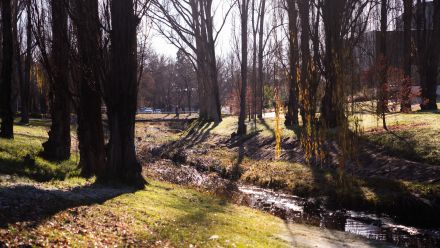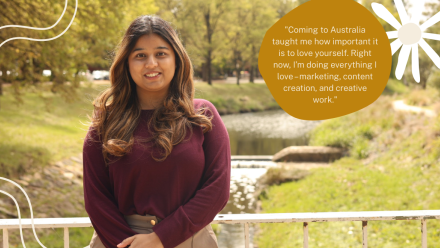Conducting a grand musical vision
Fifty years ago, Ernest Llewellyn had a dream to bring the grand musical conservatories of the US and Europe to Canberra. RICHARD FOX reports on the ever-evolving 黑料天堂School of Music in the new 黑料天堂Reporter.
to receive the next print edition of 黑料天堂Reporter.
Sleepy 1960s Canberra seems an unlikely location for a musical revolution but one man's vision composed an inspirational uprising.
It was a dream based on the world-famous Juilliard School in New York, where Australian conductor and violinist Ernest Llewellyn had studied.
With a hand-picked array of staff focused on the training of soloists, chamber and orchestral musicians, Llewellyn set about transforming Australian attitudes to music - and he wanted Canberra to be the nation's musical hub.
As a result, the Canberra School of Music opened in 1965, in modest premises within a childcare centre in Manuka. Llewellyn had recently left his position at the Sydney Symphony Orchestra and relished the challenge to create a new school in Canberra.
He insisted it should aim for standards comparable with the high level of research and teaching already occurring at ANU.
Within a year, he had gathered outstanding teachers and performers, including violinist Vincent Edwards, tenor William Herbert and pianist and composer Larry Sitsky.
Canberra was going to boom
Sitsky was persuaded to move to Canberra after previously performing with Llewellyn. He was appointed head of keyboard studies in 1966 and to this day remains part of daily life at the School.
"I never officially applied for the job," Sitsky says.
"Ernie [Llewellyn] knew me and we had performed when he was concert master. The population of Canberra was about 50,000 and I realised the place was going to boom."
Now Emeritus Professor at the School, Sitsky says he developed a strong bond with Llewellyn through performing and a love of Australian music.
"Some of the performances I did with Ernie were enriching because it was two-way thing.
"He was playing repertoire that he was familiar with and I hadn't played that much classical music because I was more interested in 20th Century music.
"It worked quite well and it was fun.
"When I was a student in San Francisco, I realised they knew nothing about Australian music. So one of my first activities there was to put on a concert of Australian music.
"They were goggle-eyed because they thought we didn't have electricity and kangaroos were running on the streets."
Llewellyn's presence in Canberra earned him an invitation for the role of conductor of the Canberra Symphony Orchestra and this started a close relationship between it and the School.
The grand conservatories of the US and Europe
By 1976, when the School moved from Manuka to the now Llewellyn Hall, Llewellyn's School ranked among the best in Australia.
"Llewellyn's vision for the School was based on the curriculum of the grand conservatories of the US and Europe," current Head of School Peter Tregear says.
"He thus established the School around a hand-picked staff of instrumental teachers to focus on the training of soloists, chamber and orchestral musicians. It was then, and remains, a powerful and attractive model to emulate."
Llewellyn retired in 1980 and by 1988, the School joined with the neighbouring School of Art in a statutory authority known as the Canberra Institute of the Arts.
However, no sooner had that happened than federal education minister John Dawkins signalled his intention that the Institute should be amalgamated into ANU.
A music research powerhouse
This increased the School's focus on research and, in 1990, Robyn Holmes joined with a vision of creating a powerhouse of Australian music research.
"One of my key roles was to develop an infrastructure of research," Holmes says.
"The performers were vibrant and doing something special but my big role was to integrate the performance, composition and research threads of Australian music. It had never really been done before."
Holmes, now senior curator at the National Library of Australia (NLA) and one of the School's Distinguished Artists in Residence, was pivotal to the securing of government funding for major research collaborations and built a network of researchers that included postgraduate students, academics and the Canberra-based national institutions.
The School, in a partnership with three other universities and three national institutions, was then awarded the largest Australian Research Council research infrastructure grant for the arts to that date.
Ultimately, it led to the development of Music Australia at the NLA which, in turn, led to the Library's Trove search engine.
"Llewellyn, John Painter, Sitsky and others were visionaries but the School needed to be galvanised to fit into the University," she says.
"You don't have scientists without a lab, so you shouldn't have musicians without research."
Jazz at the 黑料天堂School of Music
Across the other side of Canberra, a jazz campus flourished. Still in Manuka, the School's Jazz campus had up to 95 students at any one time, according to lecturer John Mackey.
"Manuka was like a little creative village; we were separate to the main school and it enabled a creative atmosphere to grow," he says.
"The model we used enabled students when they graduated to have a broad skill base over many genres. It was an open-minded approach."
Jazz campus alumni played at festivals around the world and recorded in a number of genres, including pop, with the likes of Jimmy Barnes and Silverchair.
In 2001, the jazz courses were integrated into the 黑料天堂campus and relocated to the Peter Karmel Building. Mackey recalls it being a big change.
"The dynamic changed, the new building felt sterile so we did everything we could to soften it. But we still kept on producing well educated, talented students."
For all the successes, it's fair to say it's not all been smooth sailing. Controversies have peppered the School's history, with the jazz courses hard hit by restructuring in 2012.
"It was a big change to move from a conservatorium model to a university model," Mackey says.
"Jazz is taught on a much smaller scale but the courses we now offer give something extra to the students."
Still leading the way
Today, the School is still a leading centre for research and music education.
"Llewellyn certainly set a benchmark of artistic quality and achievement, which the School rightly continues to strive to honour," Tregear says.
"I see the 黑料天堂School of Music as continuing to grow as a national centre of excellence in music performance, scholarship and outreach.
"It will continue to ensure that it offers a curriculum that best enables students to understand and articulate to others why music matters and empowers them to take a leadership role in shaping Australia's musical future."
Sitsky agrees, saying a focus on Australian music is vital.
"It's important because if we don't study our own culture no one else is going to do it.
"If we don't do it, we are saying to the world it's not important."


